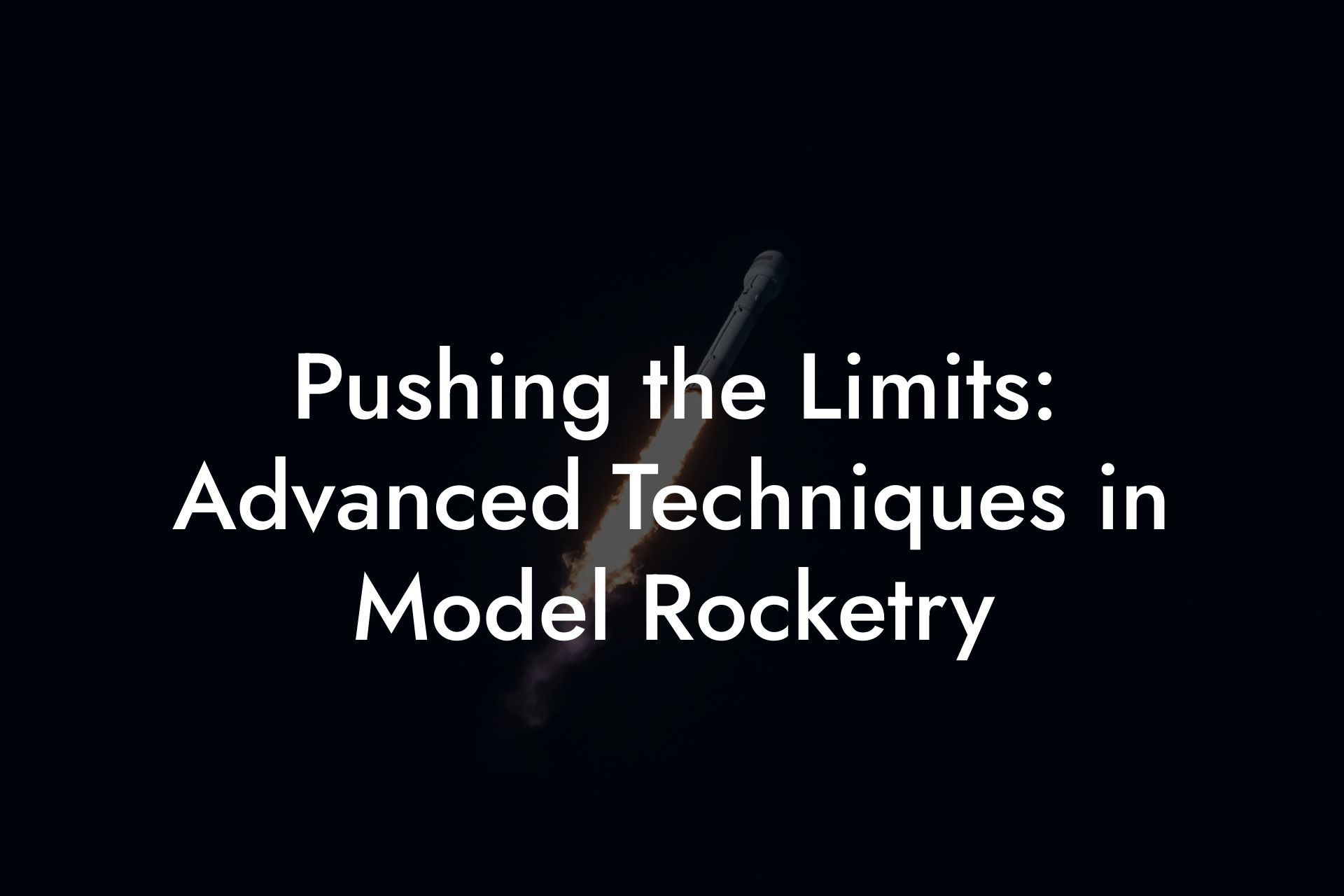For those ready to transcend the basics and redefine the boundaries of what’s possible, "Pushing the Limits: Advanced Techniques in Model Rocketry" is your ultimate guide to taking your rocketry skills to new, uncharted heights. In this comprehensive exploration, we delve into sophisticated design strategies, precision engineering, and innovative technologies that empower you to build, launch, and recover rockets like never before. Whether you’re a dedicated hobbyist or an aspiring aerospace engineer, these advanced techniques will challenge you to innovate, experiment, and push your limits.
Quick Links to Useful Sections
- Introduction: Beyond the Basics
- Advanced Design and Engineering Techniques
- Utilizing Advanced Materials
- Computer-Aided Design (CAD) and Simulation
- Innovative Propulsion Techniques
- Optimizing Fuel Formulations
- Variable Geometry Nozzles
- Hybrid and Experimental Propulsion
- Digital Integration and Telemetry
- Real-Time Telemetry and Data Logging
- Integration with Simulation Software
- Digital Control Systems
- Advanced Recovery Techniques
- Multi-Stage Recovery Systems
- Active Recovery Control
- Enhanced Deployment Mechanisms
- Case Studies: Pushing the Boundaries of Advanced Rocketry
- The Precision Ascent
- The Modular Innovator
- The Smart Rocket
- Model Rocket Advanced Rocketry FAQs
- Your Next Launch: Innovate, Experiment, and Reach for the Stars
Introduction: Beyond the Basics
Model rocketry has evolved far beyond the simple kit-based launches of the past. Today’s advanced rocketeers blend engineering, physics, and creative design to build rockets that are not only visually stunning but also perform at the cutting edge of technology. In this guide, we explore advanced materials, propulsion systems, telemetry, and digital integration, along with innovative recovery and multi-stage techniques. Get ready to challenge convention, explore new design paradigms, and push your rocketry projects to the next level.
Advanced rocketry is all about iterative learning and data-driven improvements. By mastering these techniques, you can optimize performance, maximize altitude, and achieve unprecedented stability. Let’s embark on this journey into the realm of advanced model rocketry.
Advanced Design and Engineering Techniques
Pushing the limits begins with innovative design. Advanced rocketeers employ a blend of cutting-edge materials, computer-aided design (CAD), and simulation tools to create rockets that excel in both form and function.
Utilizing Advanced Materials
Modern rocketry has seen a surge in the use of advanced composites and hybrid materials. Carbon fiber, fiberglass, and Kevlar offer superior strength-to-weight ratios, enabling the construction of lightweight yet robust structures. Incorporating nanomaterials and bio-composites can further enhance durability and aerodynamic performance.
Looking For The Best Model Rocket Kits? You'll Love These:
- Carbon Fiber: Provides unmatched rigidity with minimal weight, ideal for high-performance rocket bodies and fins.
- Fiberglass: Offers a balance of strength and affordability, perfect for prototypes and experimental designs.
- Kevlar: Known for its impact resistance, Kevlar is excellent for reinforcing key stress areas in your rocket structure.
- Nano-Enhanced Composites: Emerging technologies using nanomaterials can improve heat resistance and prolong the lifespan of critical components.
Computer-Aided Design (CAD) and Simulation
Advanced rocketeers rely on CAD software like Fusion 360, SolidWorks, or SketchUp to develop detailed 3D models of their rockets. These models allow for precise measurements and modifications before any physical construction begins. Coupled with Computational Fluid Dynamics (CFD) and finite element analysis (FEA), you can simulate aerodynamic performance and stress distribution, optimizing every curve and component.
Simulation not only reduces the risk of failure but also saves time and resources by allowing you to test multiple design iterations virtually.
Innovative Propulsion Techniques
Propulsion is the engine that drives your rocket’s success. Beyond standard solid, hybrid, and liquid engines, advanced rocketeers explore innovative propulsion concepts to maximize thrust and efficiency.
Optimizing Fuel Formulations
Experimenting with custom fuel mixtures can yield significant performance gains. Advanced rocketeers adjust the oxidizer-to-fuel ratio and incorporate additives to enhance burn consistency and impulse. Digital control systems now enable fine-tuning of combustion parameters in real time.
Variable Geometry Nozzles
One of the most exciting innovations in propulsion is the variable geometry nozzle. These nozzles can adjust their shape during flight, optimizing the exhaust flow for different atmospheric conditions and flight phases. This dynamic adjustment can improve thrust efficiency and reduce drag, leading to higher altitudes and smoother flights.
Hybrid and Experimental Propulsion
While traditional propulsion methods remain popular, some advanced enthusiasts are venturing into hybrid and experimental engine designs. These systems combine elements of solid and liquid propulsion, allowing for throttle control and multiple burn phases. Although complex, these systems offer unparalleled control and efficiency for those willing to invest in advanced engineering.
Digital Integration and Telemetry
Modern technology is transforming model rocketry by integrating digital systems that provide real-time data and advanced control during flight.
Real-Time Telemetry and Data Logging
Onboard sensors, such as accelerometers, gyroscopes, and altimeters, capture detailed flight data that can be transmitted to ground stations in real time. This data enables you to monitor the rocket’s performance as it happens and make adjustments for future launches.
Integration with Simulation Software
By feeding telemetry data back into simulation models, you can fine-tune your rocket’s design with remarkable precision. This feedback loop allows for continuous improvement, as each launch provides valuable insights into how your rocket behaves under real-world conditions.
Digital Control Systems
Advanced launch systems now incorporate microcontrollers and digital sensors to manage engine ignition, throttle control, and even recovery system deployment. These systems offer the ability to adjust flight parameters on the fly, ensuring optimal performance throughout the flight.
Advanced Recovery Techniques
Recovery is as crucial as the launch itself, and advanced rocketeers are continually innovating to ensure a safe and controlled descent. Modern recovery techniques incorporate both passive and active systems to optimize the landing.
Multi-Stage Recovery Systems
Multi-stage recovery involves using separate recovery devices for different sections of a multi-stage rocket. This approach not only protects critical components but also improves overall landing performance by tailoring recovery methods to each stage’s characteristics.
Active Recovery Control
Some advanced systems use active control techniques, such as adjustable fins or variable drag devices, that modify the rocket’s descent in real time. These innovations can compensate for wind gusts and other environmental factors, ensuring a smooth and stable landing.
Enhanced Deployment Mechanisms
Refinements in ejection charge timing and recovery device packaging can significantly impact performance. Advanced rocketeers experiment with precise delay elements and optimized packing techniques to ensure that recovery systems deploy exactly when needed for the gentlest possible landing.
Case Studies: Pushing the Boundaries of Advanced Rocketry
Real-world examples illustrate how advanced techniques can revolutionize model rocketry:
The Precision Ascent
One rocketeer utilized CFD simulations and digital telemetry to fine-tune their rocket’s aerodynamics. By optimizing the nozzle design and adjusting the fuel mixture, they achieved a 30% increase in altitude and significantly smoother flight dynamics.
The Modular Innovator
Another enthusiast embraced modular design principles to build a rocket that could be quickly reconfigured between launches. This flexibility allowed for rapid experimentation with different propulsion and recovery setups, leading to groundbreaking improvements in performance and reliability.
The Smart Rocket
A team of advanced rocketeers integrated real-time digital controls and adaptive recovery systems into their design. Their smart rocket could adjust its fin angles mid-flight and modulate engine performance based on live telemetry, resulting in unprecedented control and precision.
These case studies highlight the transformative potential of advanced techniques in pushing the limits of model rocketry.
Model Rocket Advanced Rocketry FAQs
Here are some frequently asked questions that cover key aspects of advanced model rocketry:
1. What advantages do composite materials offer over traditional materials?
Composite materials provide superior strength-to-weight ratios, enhanced durability, and improved aerodynamic properties, enabling higher performance and more resilient rocket designs.
2. How can variable geometry nozzles improve engine efficiency?
They allow for dynamic adjustment of the exhaust flow, optimizing thrust during different phases of flight and reducing energy losses due to drag.
3. What role does real-time telemetry play in advanced rocketry?
Real-time telemetry offers immediate feedback on flight parameters, allowing for precise adjustments and iterative improvements to rocket design and performance.
4. Are smart control systems practical for home-built rockets?
Yes, with the increasing availability of affordable microcontrollers and sensors, smart control systems are becoming more accessible for hobbyists, enabling real-time adjustments and enhanced flight stability.
5. What benefits do modular rocket designs offer?
Modular designs enable rapid prototyping, easy upgrades, and flexibility in testing various configurations without rebuilding the entire rocket.
6. How do advanced recovery systems contribute to flight safety?
Enhanced recovery systems, such as multi-stage or active control recovery, minimize landing impact and protect rocket components, ensuring safer and more reliable recoveries.
7. Can advanced propulsion systems be implemented safely in home-built projects?
Yes, with proper design, adherence to safety protocols, and thorough testing, advanced propulsion systems can be safely integrated into custom rockets.
8. What digital tools are essential for advanced flight analysis?
High-resolution data loggers, CFD simulation software, and digital sensors are critical for capturing and analyzing flight data to inform design improvements.
9. How do eco-friendly propellants impact advanced rocket performance?
Eco-friendly propellants reduce environmental impact without sacrificing performance, and ongoing research continues to enhance their efficiency and reliability.
10. What are the latest trends in advanced model rocketry?
Trends include the integration of nanomaterials, digital control systems, modular designs, adaptive recovery mechanisms, and eco-friendly propulsion innovations.
Your Next Launch: Innovate, Experiment, and Reach for the Stars
Advanced rocketry is a frontier of endless possibilities. By pushing the limits with cutting-edge materials, innovative propulsion, and digital integration, you’re not just building a rocket, you’re shaping the future of model rocketry. Embrace the challenges, learn from every flight, and let your passion drive you to experiment boldly.
With each launch, you refine your techniques, innovate your designs, and inch closer to the pinnacle of performance. The journey to the stars is paved with knowledge, creativity, and an unyielding desire to excel. So, gear up, push the limits, and let your advanced rocketry adventures take you to new heights.
Looking For The Best Model Rocket Kits? You'll Love These:
Useful Interruption: Dive deeper into the world of Model Rockets with our most popular sections. If there is anything you think is missing or anything you would love for us to write about, just give us a shout.
- Getting Started & Basics With Model Rockets
- Model Rocket Design, Build & Customization
- Model Rocket Propulsion & Engine Technology
- Model Rocket Launch Techniques & Recovery
- Model Rocket Advanced Rocketry & Innovations
- Model Rocket DIY and Customization
- Model Rocket Equipment Reviews & Digital Tools
- Community, Competitions & Education
- Model Rocket Troubleshooting & FAQs
- Model Rocket Bonus/Seasonal & Niche Topics
A group of model rocket enthusiasts gathered at a field for their weekly launch event. Among them was Dave, a seasoned builder known for pushing the limits of hobby rocketry. This time, he had outdone himself.
“Ladies and gentlemen,” Dave announced, dramatically pulling a cloth off his latest creation, “I present to you: The Kraken!”
The crowd gasped. This wasn’t just a model rocket, it was a monster. The thing stood 8 feet tall, had six clustered engines, and was covered in enough duct tape to qualify as a classified aerospace project.
“Dave,” muttered Steve, the cautious safety officer, “Have you, uh… done the math on this?”
“Math?” Dave scoffed. “I built it in my garage at 3 a.m. with parts from eBay. This is an art piece, Steve.”
The countdown began.
5…
4…
3…
2…
1…
The engines ignited with a BOOM, and The Kraken shot up… kind of. It immediately did a violent barrel roll, narrowly missing the spectators before skyrocketing at an angle that could only be described as “legally questionable.”
The crowd collectively ducked as The Kraken flew straight over the adjacent cornfield, where Old Man Jenkins, the grumpiest farmer in town, was minding his business.
KABOOM!
The rocket disappeared behind the barn. A moment later, a flaming piece of Estes igniter wire landed at Steve’s feet. The silence was deafening.
And then, an unmistakable sound echoed across the field.
Jenkins’ shotgun being cocked.
“DAVE!!!” Steve shouted. “RUN.”
And that was the day Dave invented the first-ever biologically powered rocket booster: pure adrenaline.
To this day, nobody knows where The Kraken landed, but legend has it, it still haunts the skies, terrifying unsuspecting drones and low-flying birds.






